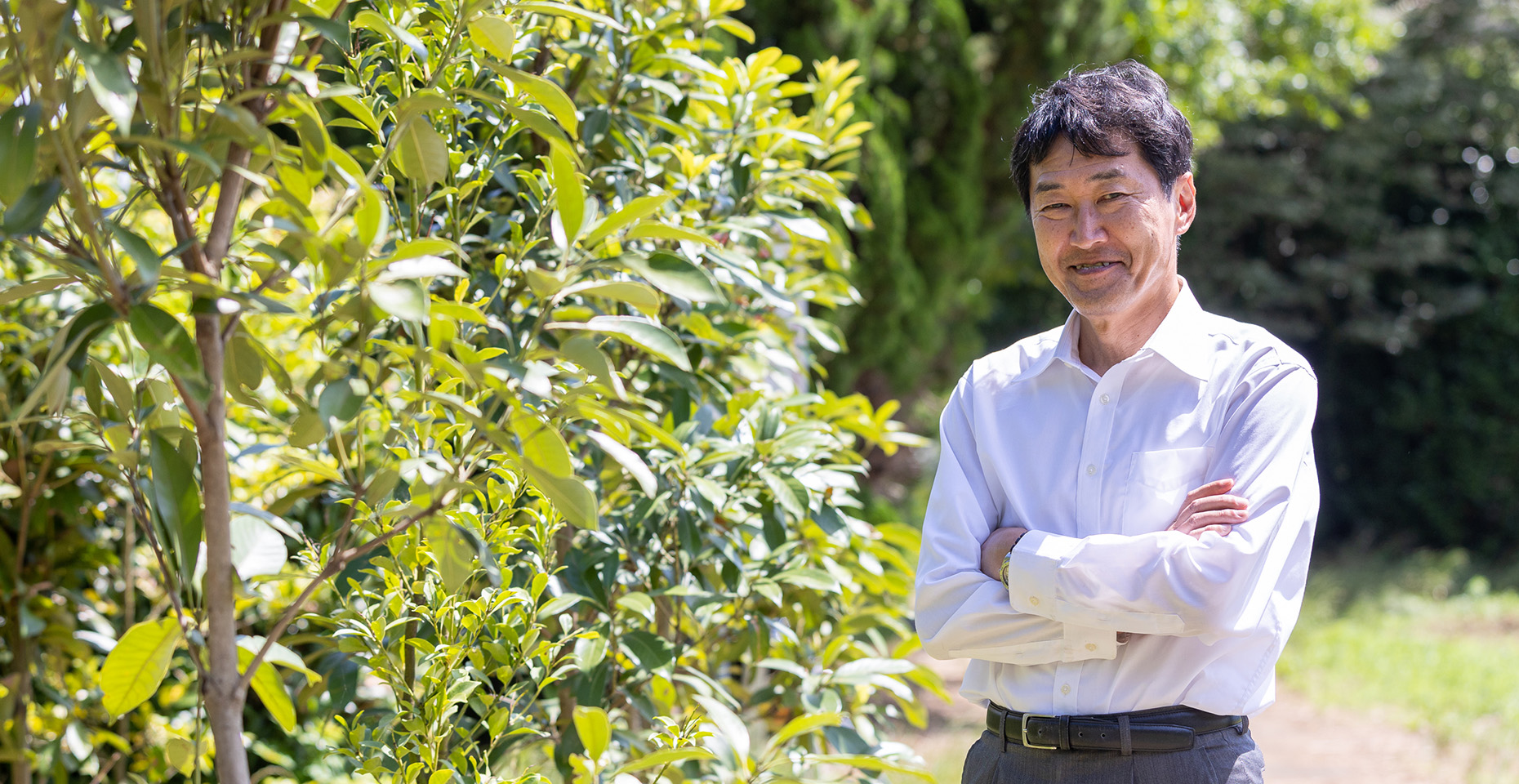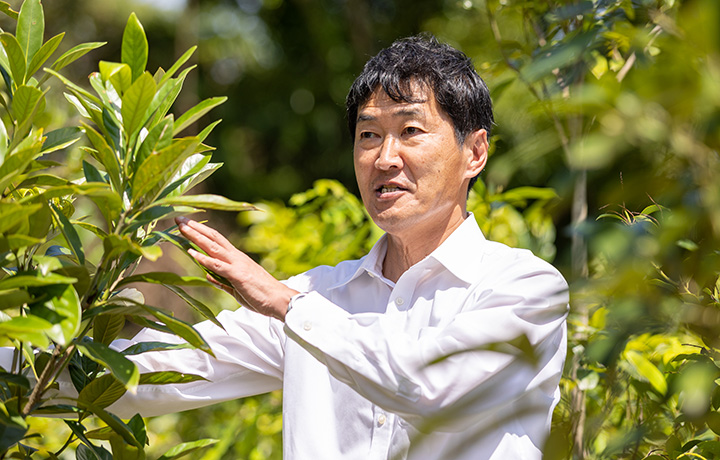The issues facing contemporary society are seldom addressed through research confined to laboratories.
Professor Tatsuaki Kobayashi has had a decades-long interest in environmental issues and sustainable societies. He has been performing fieldwork for more than 40 years, exploring the possibilities of restoration ecology in situ. This science aims at re-establishing self-sustainable ecosystems in natural environments. Dr. Kobayashi studies environmental issues by comprehending the entirety of regional problems, including those involving people. His focal point is engaging with these problems and transcending the limitations of mere academics.
Chiba University is the only national university with a Faculty of Horticulture. It is here that Dr. Kobayashi has moved his research forward without limitations. We spoke with him about starting his Restoration Ecology Laboratory, and his current interests and pursuits.
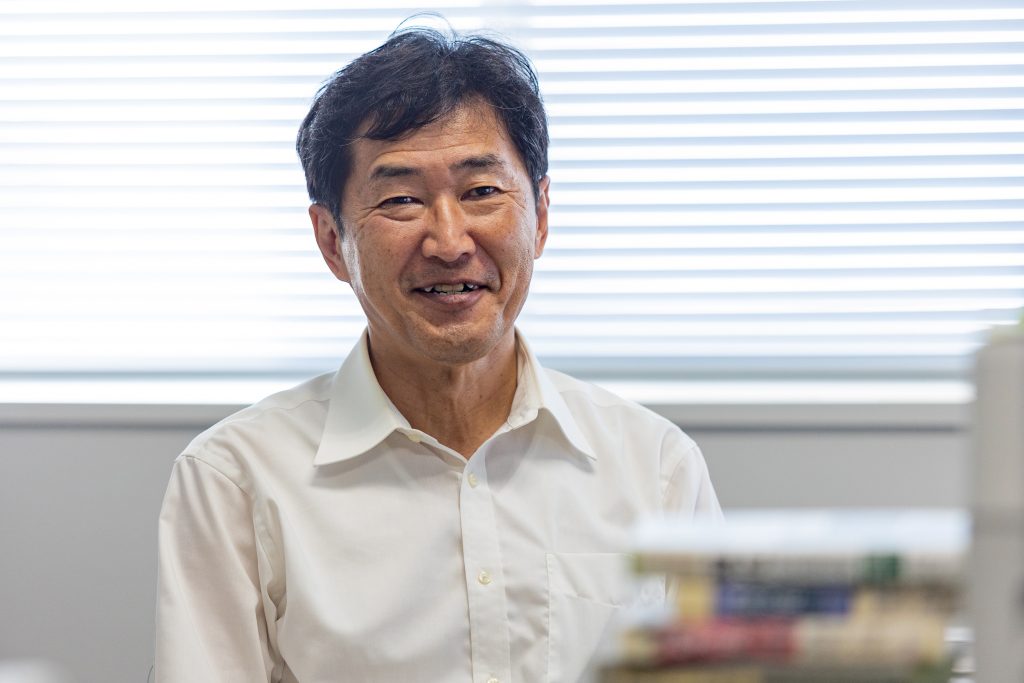
Restoration Ecology is a conversation with the land in the scope of landscape
Dr. Kobayashi, please tell us about the principles of Restoration Ecology.
Restoration Ecology considers that the formation of the ecological environment is inseparable from the effect of human activities. This science aims for the formation of sustainable societies and the nurturing of resilient ecosystems.
This means recovering and restoring local ecosystems that have been damaged by human actions, and the development of dedicated “ecological restoration technologies” for nurturing healthy natural environments available also for human interactions. Restoration ecology ardently pursues the creation of sustainable localities and regions.
So, you think of the ecological system as a mutually influencing landscape.
“Ecosystem services” are the benefits we obtain from ecological systems through interactions among diverse living things. Such services involve the effects of mutual inter-workings of a broad spectrum of elements. While their workings differ locally, one can also find typical patterns, of various element assemblies and arrangements, their respective ordering, etc. “Landscape science” explores these complex connections, so as to find appropriate land usages and designs. We perform fieldwork in local areas, and then perform spatial-distribution surveys and analyses. Our aim is to find out what these phenomena are telling us.
The exhilarating excitement of adventure during field research
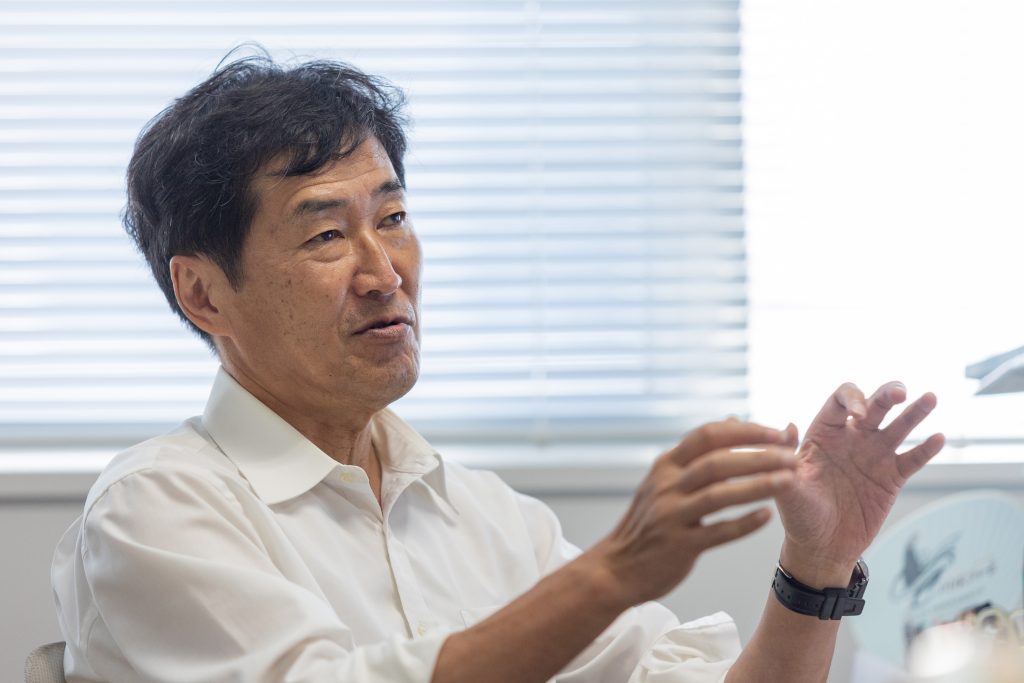
Dr. Kobayashi, please tell us how you started out researching restoration ecology.
I chose Kyoto University’s Faculty of Agriculture owing to my original enjoyment of interacting with nature. In my undergraduate years, I enjoyed walking through mountains, along rivers, and by the ocean as a member of the Explorers Club of Kyoto University. I liked the excitement of not knowing what we might see next, and this feeling was linked later to my research in the field.
Since that time, I have been engaged with ecological issues, which constitute the basis of the environment. Now, Chiba University is the only national university with a Faculty of Horticulture, and it had just the right place for me: the Department of Environmental Science and Landscape Architecture. I moved there in 1984, and I have been pursuing research there ever since.
The 1980s was the precise time when global environmental protection efforts were underway in earnest.
Global environmental efforts got a head start with the 1972 United National Conference on the Environment (UNCED) in Stockholm, Sweden. From the Rio Conference in 1992, UNCED became known as the “Earth Summit,” and in 1993, Japan established its Basic Act on the Environment.
During the 1990s, landscape architecture itself began to cover general ecology, as the entire environment, including animals as well as plants, became the subject of research in this field. This trend has gradually penetrated the general society, as we are currently engaged in Sustainable Development Goals (SDGs) and other efforts.
Fieldwork to restore ecosystem and society after natural disasters
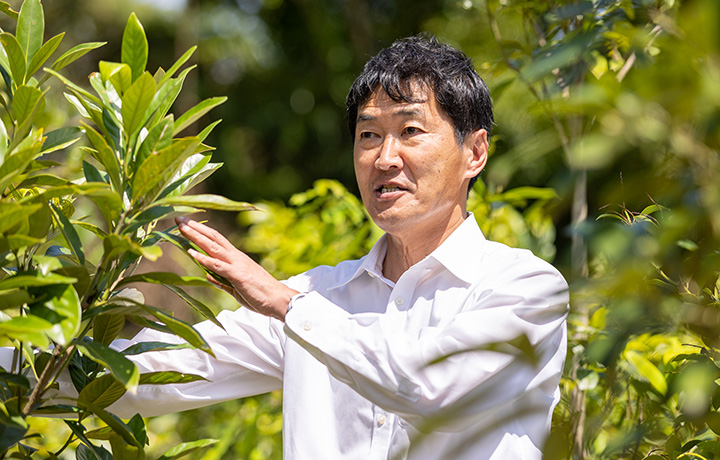
How do you perform your fieldwork exploration?
We use a variety of research methods and study a variety of site types. We are often outdoors, mainly in secondary forests, rivers, tidal flats, wetlands, and so on. However, we also study school pools, parks, roads, and even university campuses.
The Faculty of Horticulture has cultivation fields and greenhouses on campus, where we experiment and verify the hypothesis we have observed in our outdoor surveys. We also have a full range of equipment for soil and plant analyseswe need. Further, we also have the technologies for analyzing and evaluating various environmental properties and functions using geographic information systems, remote sensing, and other spatial information. We apply research methods for making objective evaluations of such things as ecosystem quality (something that has been difficult to measure in the past), and animal and plant habitats. We also use the method of local resident participation.
Recently, we have performed surveys and analyses of the restoration process in disaster-affected environments, with the additional focus being fieldwork to determine the fundamental requirements of ecosystems to survive.
So, you strive to “hear” these “voices” of the land to learn about how to restore the local environment and ecosystem after a disaster. What are some of the specific examples of such endeavors?
One example is our survey of infrastructural damage caused by fallen trees after Typhoon Faxai in 2019. The strong winds during this typhoon led to long-term power outages, accompanied by water supply outages. In Chiba Prefecture, 1,750 utility poles were uprooted. Of these, 1,311, or 75%, had been toppled by fallen trees and buildings.
Part of this was due to fallenconifers planted in Chiba Prefecture, called sanbu-sugi, which is a kind of Japanese cedar (Cryptomeria japonica). In cedar, owing to delays in thinning of excess trees, the narrow trunks had grown tall. These trees were prone to be fallen by strong winds. Moreover, stem decay due to Fomitiporia species caused the extensive break of stems. Since sanbu-sugi had been planted as part of rotation planting in crop fields, its forests are often located in the vicinity of residences, utility poles, and other infrastructure. This was one major reason for the extent of the power outage-related damages during the typhoon.
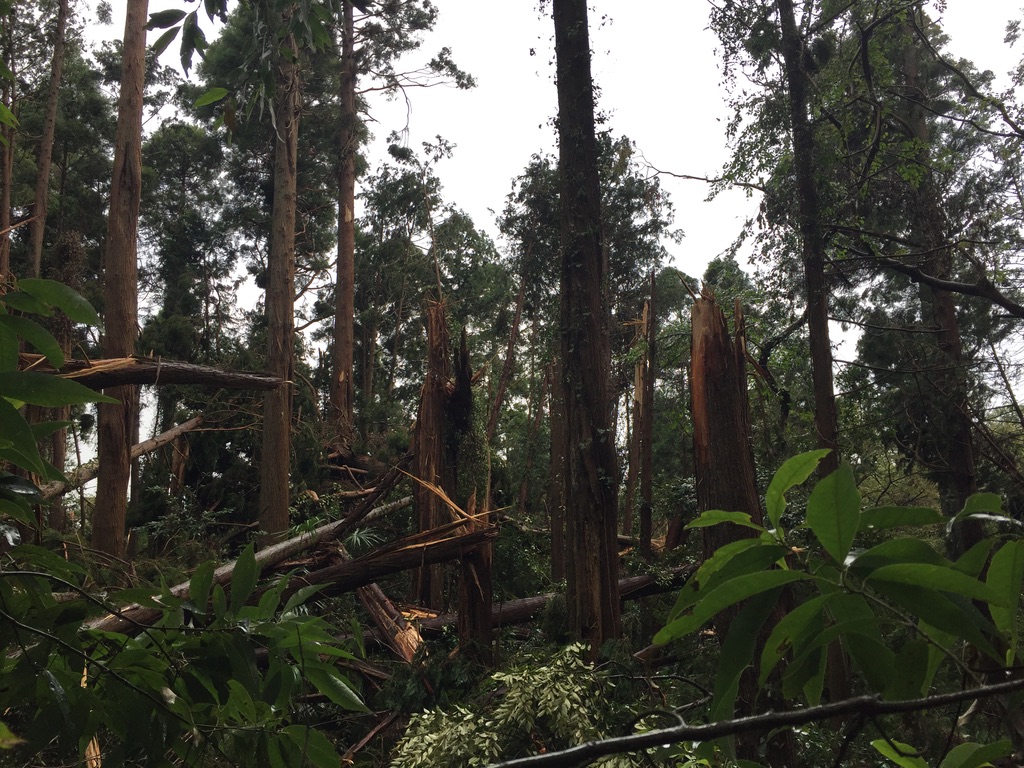
Besides, there were many groups of fallen Japanese stone oak (Lithocarpus edulis) trees. This broadleaf tree was previously thought to be more resilient to weather phenomena than evergreens, but their damage was of a record-breaking scale. Our survey found that the stone oak, an introduced alien species, had formed pure forests*, and this had negatively impacted the mechanical balance of trees and forests. In other words, both these tree types (sanbu-sugi and stone oak) had been mono-cultured, and the lack of diversity in these forests had worsened the damage.
We will use these survey results to consider alternative planting methods for the future.
*A pure forest is one where only a single species of tree is found.
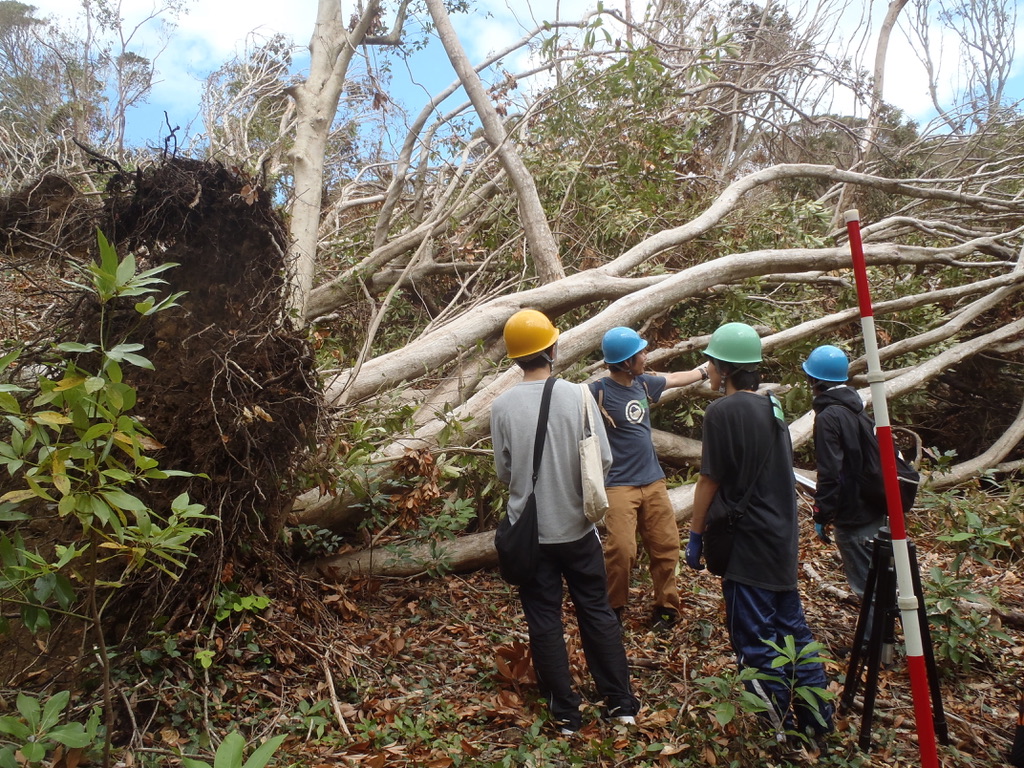
What “voices” of nature did you hear from the Great East Japan Earthquake of 2011?
As a means of protection from tsunami and sea breeze, black pine (Pinus thunbergii) forests have been planted with sand dunes along the coasts of Chiba Prefecture. After the Great East Japan Earthquake and subsequent tsunami in 2011, many houses along the coastlines unprotected by forests, as well as those along rivers and roads, were completely destroyed, and the damage was massive. Meanwhile, there was considerably less destruction of houses in the areas protected by coastal forests, despite widespread water penetration. The benefits of coastal forest plantation with sand dunes against tsunami were clear.
Restoration of the ecosystem is necessary, including oceans, mountains, and rivers, regarding human life. Careful reorganization of natural elements must be done in a manner that ensures sustainability in local areas. This means ensuring that the natural capabilities of the forest themselves—even of human-planted forests—are fully operational, and research is needed in all domains to provide lateral support so that “ecological services” can be provided to the full extent. This is not limited to simple examples and “what-if” scenarios. Many unknown events are bound to occur in the future. One of these is an accident at a nuclear power plant. We were involved in analyzing and predicting the movement of radioactive cesium in the town of Kawamata in Fukushima Prefecture. Before the Fukushima nuclear plant accident due to the tsunami of 2011, this area followed the patterns of Satoyama landscapes (that is, for example, the cultivation of lower slopes while living in upland valleys, etc.), as well as agriculture. Hence, we surveyed not only the natural environment, but also the circulation of cesium in that environment. We were the only ones to perform large-scale experimentation on ways of decontaminating the forests, as was the strong desire of the local people, and even now, we continue tracking cesium. This was the first time we had an opportunity to think about the ecosystem cycle over such a broad area.
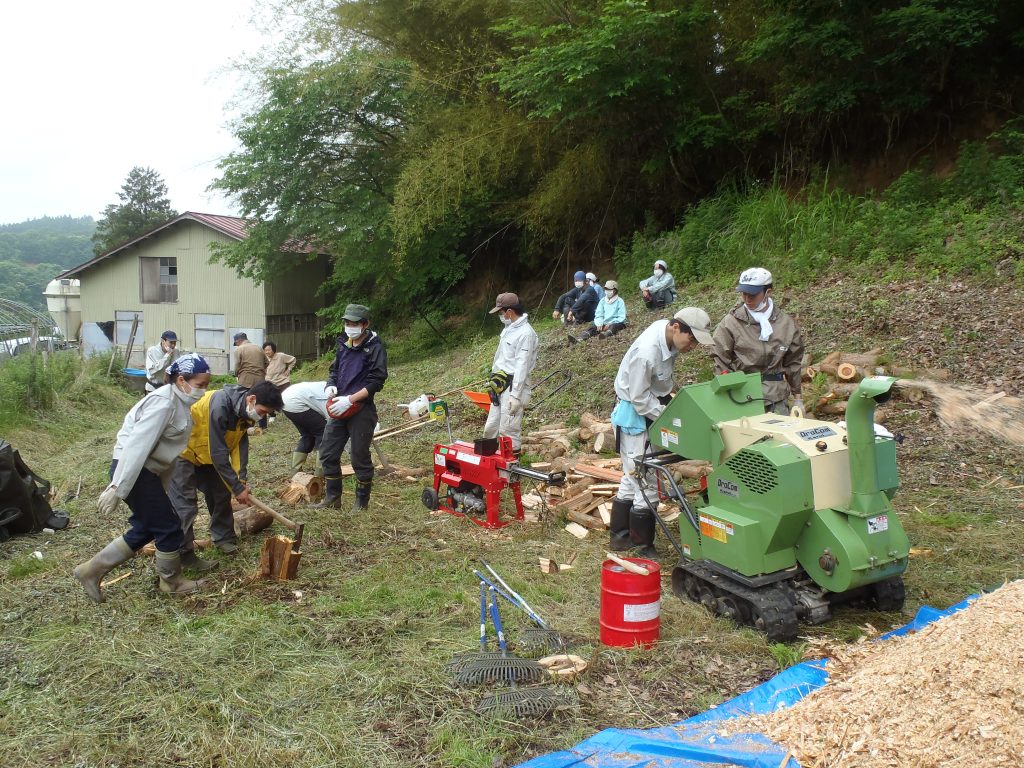
Dr. Kobayashi’s Restoration Ecology Laboratory serves as a bridge uniting nature, citizens, and local governments
To gain a comprehensive understanding of local nature for a more thorough analysis, we have performed fieldwork involving interviews and exchanges with local residents. This is because the ways of thinking and the culture of the people who live in the land provide insights into the natural surroundings.
In the town of Kawamata in Fukushima Prefecture, we asked local people what they were most anxious about in terms of the cesium contamination. They said that, more than agricultural lands, their primary concern was the forests. One reason is that the local water is taken directly from forest sources in the surrounding mountainside. Through the ages, the forests have provided food and other resources necessary to sustain life during the harsh cool damage of rice-crop. The local people know that life would not have been possible without the circulation of life-sustaining resources in the local mountain forests. And these uncertainties/anxieties about daily life went beyond the daily changes in the radiation levels—they are advocates of holism who want to safeguard the functioning of the entire local region.
This was something we could only discover through our fieldwork and once again confirmed the importance of dialogue with local residents. We issue annual reports as well, so as to provide lateral support for communication between local residents and the national and other governments.
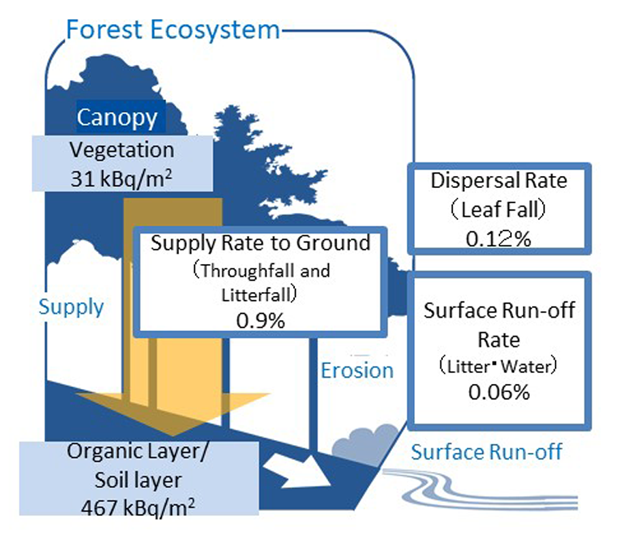
(Half-life correction based on the data in March 2011 and 2015)
Even as you strive to improve human understanding of the environment, dialogue with local citizens seems to be the base and starting point for improving the local ecosystem and other functions.
The increased natural disasters resulting from the climate change also provide opportunities for a reorganization of ecosystems. The university enters the field to link scientific findings with the desires of local people and serves as a “hub” that keeps local government policies neutral. The climate of academic freedom at Chiba University makes it possible for us to support, from a neutral point of view, local restoration and revitalization efforts.
Dr. Kobayashi, what is your “final message” of this interview?
The restoration of a forest progresses in units of 50 to 100 years. That said, a post-typhoon survey can yield some results within one or two years of tree seedling growth, and our restoration efforts can have their effects in, say, five or ten years. With this understanding, we try to make predictions for half a century or one century into the future, and we make five-year plans and other efforts accordingly. We must make precise and accurate confirmation of our results, and constantly continue our fieldwork at actual sites.
Our work needs to be linked with other entities apart from just the local citizens and governments. We have also begun to work collaboratively with private companies for a new project in mountain forest areas near agricultural cultivation and residential areas. A region prospers best when government, academia, and industry work together as one, and this unity would also ensure greater resilience against natural disasters.
Our research domain, Restoration Ecology, thus encompasses a huge field, including nature and local communities. We are truly right in the middle of research that highlights the current sentiments and movements of a society keen on sustainability and carbon neutrality. We will continue to communicate to the broader society our findings on Restoration Ecology along with those related to resilience to natural disasters. Our research aims to improve the functions of communities. Our idea is to have Chiba University play a main role in these efforts and provide a superior model and benchmark for all of these essential issues.
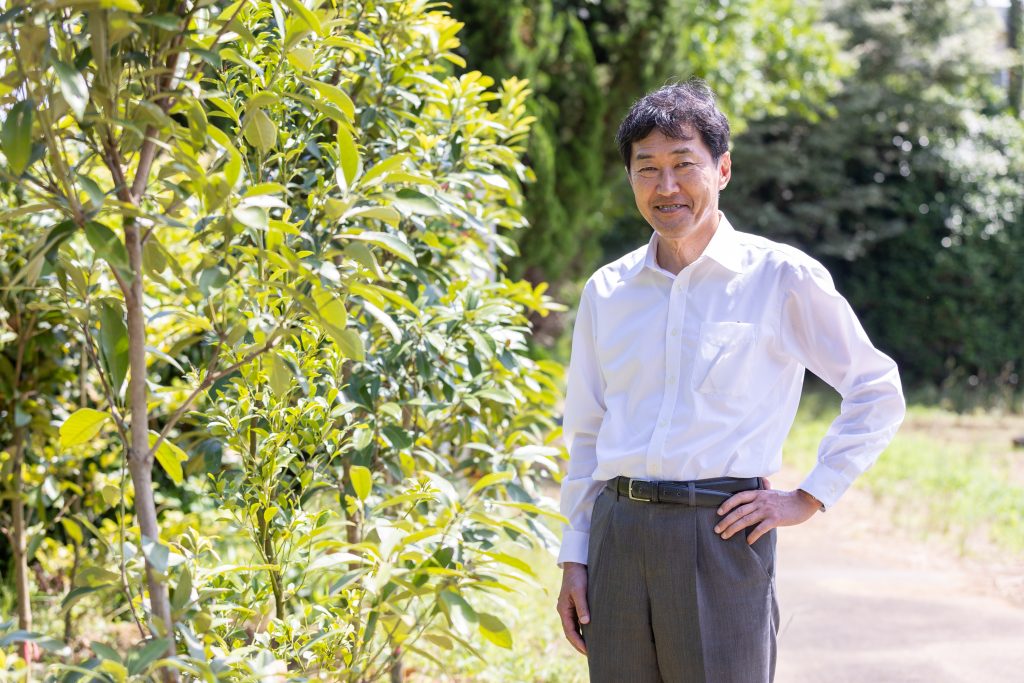
Series
Horticulture Innovation −Creating the Future of "Food" and "Greenery"−
Chiba University is the only national university that accommodates a department of horticulture in Japan. We highlight our researchers who are exploring the possibilities of Food and Landscape.
-
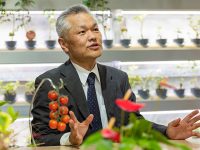
#1
2022.09.27
Fostering Global Well-being Through Horticultural Innovation
-
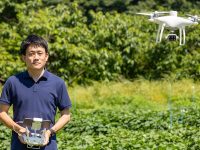
#2
2022.10.17
Making the Invisible Visible: Drones Enabling Agricultural Advances
-
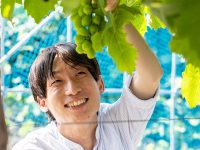
#3
2022.11.07
Designing a world-class climate-resistant fruit!~Developing “Designed Grapes” for Custom-Made Wine to Commemorate Special Occasions
-
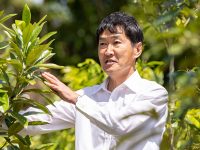
#4
2023.02.02
Towards a self-sustainable natural environment: The science of restoration ecology, where researchers engage in conversation with the earth
-
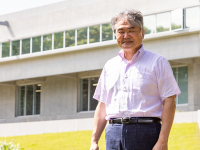
#5
2023.05.19
The reciprocity of life: The interactive relationships between people, plants, and the environment
Recommend
-
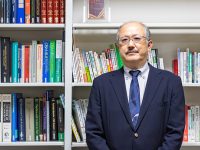
Affecting behavioral changes through a combination of mind and body: How can we calmly cope with stress in the event of a disaster?
2023.02.27
-

Designing a Comfortable Living: A Kampo Clinic that Simulates the Five Senses
2024.01.26
-
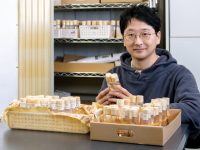
Functioning of Biological Diversity: Lessons from Ecology on the Importance of Minority Perspectives
2023.06.15


